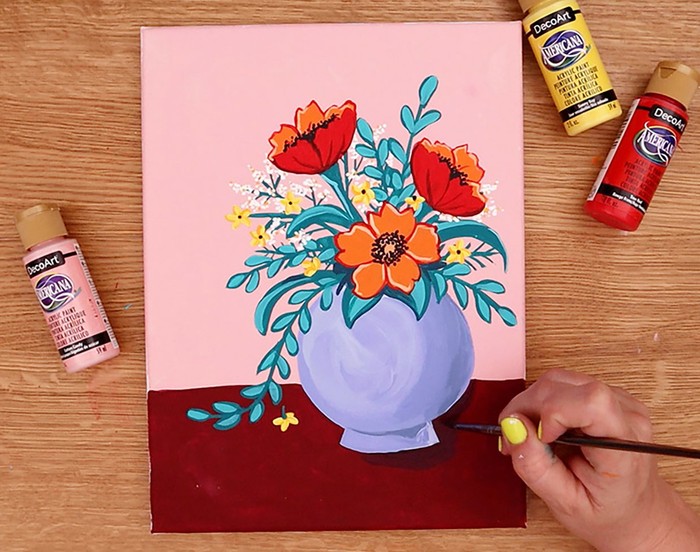Painting ideas for beginners on paper are a great way to learn about creating different shapes and colors. Start with simple scenes or objects and move on to more complex paintings as you get more practiced.
Practice using light and dark paints to create depth and shape in your artwork. Be sure to mix your own colors so that you can get a full range of hues and tones to work with.
Colors
The colors you use when painting are an important aspect of your final piece. Whether you’re using an analogous or complementary color scheme, the right colors can set a positive tone to your artwork. This makes it essential for beginners to learn about color theory before beginning a painting.
Colors are classified based on their hue, value, and intensity. The color wheel is a helpful tool for understanding the relationships between different colors. This way, you can create a harmonious color palette for your next painting.
Choosing the right paint is also important for beginners. Many beginner artists start by purchasing “student quality” acrylic paints, then switch to artist quality once they’ve gotten the hang of it. The difference between the two types of paint is that student quality paints have a higher percentage of filler in them, which can cause the paint to dry slower.
To avoid this problem, it’s recommended to purchase the highest quality paint that you can afford. This will ensure that your paint dries quickly, and won’t be prone to cracking or flaking as it sits on the canvas for longer periods of time. For even more peace of mind, buy a set that comes with black and white so that you can test your color combinations before committing to a full paint palette.
Composition
The subject of the painting is important, but equally so is a strong design. It’s easy to focus on color, brushstrokes and edge handling – but without a strong composition, a painting may not be as powerful or interesting.
Consider the placement of your center of interest (the subject that is most important to you). You may want to place a second center of interest in the painting to give balance to the work. If you choose to do this, be sure not to place them close together, as they will compete with each other for attention. Instead, you may wish to place them further apart and use other elements in the painting to accentuate their differences.
Keeping shapes simple is also very important to composition. It’s possible to add a lot of complexity to a painting by adding details such as shadows, highlights and textures, but beginners are advised to keep things more abstract and simpler. It’s a great way to build your skills while creating a more aesthetically pleasing painting.
Lines are very powerful and our eyes like to follow them. They can help to create direction, movement or emphasize key structures in a painting. Look for opportunities to convey your ideas through the lines in your paintings, such as a hint of direction in grass or hair extending from a head, or a series of lines that form a focal point.
Brushstrokes
The brushstrokes of a painting convey the personality of the artist. Observing an expert painter at work gives you insight into what they were thinking and feeling at the moment of creation. They also give a painting its soul.
Beginners may be intimidated by the idea of using a paintbrush to make fine strokes, but practice makes perfect. As you get more comfortable with your technique, you can start to use a wider range of brushstrokes to create the illusion of texture and movement.
Choosing a simple subject with a limited number of colors can help you focus on your brushstrokes and avoid the temptation to overdo it. For example, a simple color-blocked canvas of fruit is an easy way to experiment with organic circles and ovals without worrying about the details.
A beginner should also avoid overly complicated or photorealistic subjects. A professional artist can go into minute detail, such as painting each pore of the model’s face, but for a beginner it is best to choose larger elements and simpler compositions. For example, painting a silhouette of a couple on a sunset beach is much easier to achieve than a full-scale portrait. For even more simplicity, you can use a blotting technique that allows you to skip the blocking in phase of a painting altogether.
Materials
Painting is a versatile art form that allows you to express yourself in many different ways. It can be as simple or complex as you want it to be and is a great way to relax and de-stress. It’s important to choose the right materials when beginning a new painting project. You should select a paint medium that is easy to use and works best for your needs. This will allow you to focus on learning about the other aspects of painting, such as composition and color.
For beginners, watercolor and acrylics are popular choices. They’re easy to use, affordable and dry quickly, making them a good choice for beginner artists. If you’re unsure what to choose, ask your local art store for advice.
You can also try different painting techniques on a variety of surfaces, such as canvas or paper. This will help you get a feel for the medium and see which one you enjoy working with most. If you’re using watercolors, consider selecting a smooth paper that will absorb the paint easily. A sketchbook or journal is a good option for beginners, as it’s easier to handle and can be used for detailed studies.
Using a simple blotting technique, you can create a stunning abstract canvas that’s sure to impress your friends. This easy blotted paint idea is a fun painting project that’s perfect for beginners to try.









